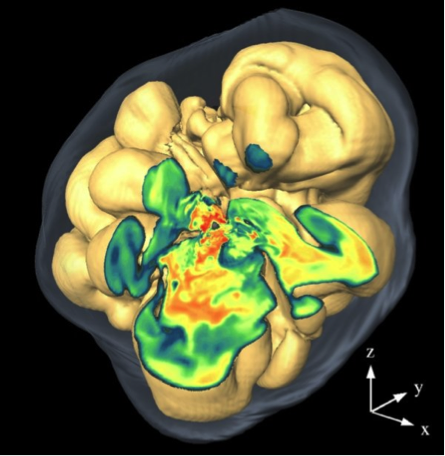Core-collapse supernovae and radioactivity
Core collapse supernovae produce most of the intermediate mass and heaviest elements in nature and dominate energy input to the galaxy, yet the mechanism of their explosion is not well understood. High-energy observations can clarify their nucleosynthesis, dynamics, possible jet formation, and stellar mass-loss. For relatively nearby core-collapses, lines from 56Co and 57Co can be measured, and would be enhanced by jets and/or dynamical mixing of core material outward. Extended time coverage and/or detailed spectroscopy of the lines can clarify these conditions. Ejecta/circumstellar matter interactions can produce hard X-ray continuum emission and clarify presupernova mass-loss. Very sensitive line measurements could probe, e.g., 26Al production and dynamics in the Vela supernova remnant, and r-process nucleosynthesis in galactic remnants. Observations of large quantities of 56Co would show that pair instability supernovae can occur in the recent universe (see the case of SN 2006gy.)
Required instrument performances:
 Three-dimensional numerical simulation of the explosion of a 15.5 solar-mass blue supergiant. The image shows the boiling of the neutrino-heated gas (color coded is the entropy) at 0.5 s after the start of the explosion. Credit: H.-T. Janka. |
Required instrument performances:
| Performance parameter | Goal value | Remarks and notes |
|
Field-of-view (FWHM, deg) |
> 2 ster | For continued monitoring and discovery of unpredictable (e.g., csm) emission. Sensitive, narrow field instruments could achieve objectives for known SNe. |
|
Angular resolution (FWHM, deg) |
Not essential | |
|
Spectral resolution (ΔE/E @ Energy) |
1000 km/s (E/ ΔE ~ 300) at 847 keV | For discriminating location of radioactivity from spectroscopy. |
|
Line sensitivity (@ Energy) (cm-2 s-1, 3σ, 1 Ms) |
10-6 cm-2 s-1 at 847 keV 10-7 cm-2 s-1 at e.g., 415 keV |
For 56Co, 57Co, 44Ti objectives For r-process, e.g. 126Sn |
|
Continuum sensitivity (in which energy band?) (cm-2 s-1 keV-1, ΔE=E, 3σ, 1 Ms) |
10-7 cm-2 s-1 keV-1 at 100 keV |
For SN ejecta/CSM interactions |
| Timing performances |
Not applicable |
|
|
Polarimetric capability (Minimum Polarization Fraction for a Crab source in 1 Ms) |
Not applicable |
|
| Real-time data? |
Not applicable |
 AstroMeV
AstroMeV